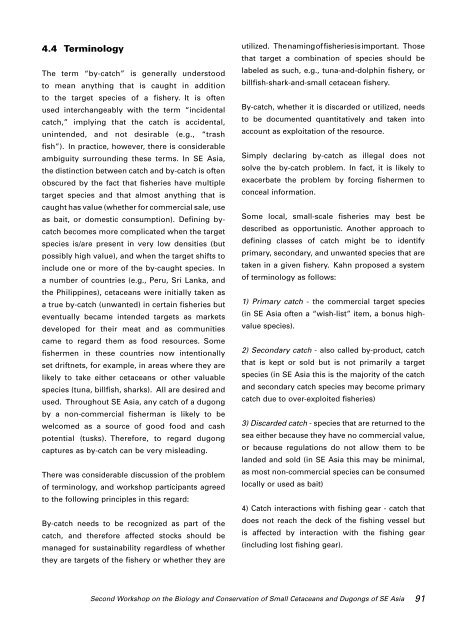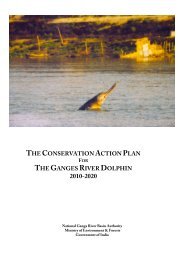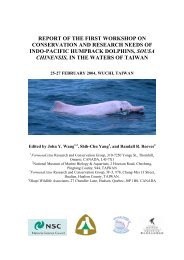4.4 Terminology<strong>The</strong> term “by-catch” is generally understoodto mean anything that is caught in additi<strong>on</strong>to <str<strong>on</strong>g>the</str<strong>on</strong>g> target species <str<strong>on</strong>g>of</str<strong>on</strong>g> a fishery. It is <str<strong>on</strong>g>of</str<strong>on</strong>g>tenused interchangeably with <str<strong>on</strong>g>the</str<strong>on</strong>g> term “incidentalcatch,” implying that <str<strong>on</strong>g>the</str<strong>on</strong>g> catch is accidental,unintended, <strong>and</strong> not desirable (e.g., “trashfish”). In practice, however, <str<strong>on</strong>g>the</str<strong>on</strong>g>re is c<strong>on</strong>siderableambiguity surrounding <str<strong>on</strong>g>the</str<strong>on</strong>g>se terms. In SE Asia,<str<strong>on</strong>g>the</str<strong>on</strong>g> distincti<strong>on</strong> between catch <strong>and</strong> by-catch is <str<strong>on</strong>g>of</str<strong>on</strong>g>tenobscured by <str<strong>on</strong>g>the</str<strong>on</strong>g> fact that fisheries have multipletarget species <strong>and</strong> that almost anything that iscaught has value (whe<str<strong>on</strong>g>the</str<strong>on</strong>g>r for commercial sale, useas bait, or domestic c<strong>on</strong>sumpti<strong>on</strong>). Defining bycatchbecomes more complicated when <str<strong>on</strong>g>the</str<strong>on</strong>g> targetspecies is/are present in very low densities (butpossibly high value), <strong>and</strong> when <str<strong>on</strong>g>the</str<strong>on</strong>g> target shifts toinclude <strong>on</strong>e or more <str<strong>on</strong>g>of</str<strong>on</strong>g> <str<strong>on</strong>g>the</str<strong>on</strong>g> by-caught species. Ina number <str<strong>on</strong>g>of</str<strong>on</strong>g> countries (e.g., Peru, Sri Lanka, <strong>and</strong><str<strong>on</strong>g>the</str<strong>on</strong>g> Philippines), cetaceans were initially taken asa true by-catch (unwanted) in certain fisheries buteventually became intended targets as marketsdeveloped for <str<strong>on</strong>g>the</str<strong>on</strong>g>ir meat <strong>and</strong> as communitiescame to regard <str<strong>on</strong>g>the</str<strong>on</strong>g>m as food resources. Somefishermen in <str<strong>on</strong>g>the</str<strong>on</strong>g>se countries now intenti<strong>on</strong>allyset driftnets, for example, in areas where <str<strong>on</strong>g>the</str<strong>on</strong>g>y arelikely to take ei<str<strong>on</strong>g>the</str<strong>on</strong>g>r cetaceans or o<str<strong>on</strong>g>the</str<strong>on</strong>g>r valuablespecies (tuna, billfish, sharks). All are desired <strong>and</strong>used. Throughout SE Asia, any catch <str<strong>on</strong>g>of</str<strong>on</strong>g> a dug<strong>on</strong>gby a n<strong>on</strong>-commercial fisherman is likely to bewelcomed as a source <str<strong>on</strong>g>of</str<strong>on</strong>g> good food <strong>and</strong> cashpotential (tusks). <strong>The</strong>refore, to regard dug<strong>on</strong>gcaptures as by-catch can be very misleading.<strong>The</strong>re was c<strong>on</strong>siderable discussi<strong>on</strong> <str<strong>on</strong>g>of</str<strong>on</strong>g> <str<strong>on</strong>g>the</str<strong>on</strong>g> problem<str<strong>on</strong>g>of</str<strong>on</strong>g> terminology, <strong>and</strong> workshop participants agreedto <str<strong>on</strong>g>the</str<strong>on</strong>g> following principles in this regard:By-catch needs to be recognized as part <str<strong>on</strong>g>of</str<strong>on</strong>g> <str<strong>on</strong>g>the</str<strong>on</strong>g>catch, <strong>and</strong> <str<strong>on</strong>g>the</str<strong>on</strong>g>refore affected stocks should bemanaged for sustainability regardless <str<strong>on</strong>g>of</str<strong>on</strong>g> whe<str<strong>on</strong>g>the</str<strong>on</strong>g>r<str<strong>on</strong>g>the</str<strong>on</strong>g>y are targets <str<strong>on</strong>g>of</str<strong>on</strong>g> <str<strong>on</strong>g>the</str<strong>on</strong>g> fishery or whe<str<strong>on</strong>g>the</str<strong>on</strong>g>r <str<strong>on</strong>g>the</str<strong>on</strong>g>y areutilized. <strong>The</strong> naming <str<strong>on</strong>g>of</str<strong>on</strong>g> fisheries is important. Thosethat target a combinati<strong>on</strong> <str<strong>on</strong>g>of</str<strong>on</strong>g> species should belabeled as such, e.g., tuna-<strong>and</strong>-dolphin fishery, orbillfish-shark-<strong>and</strong>-small cetacean fishery.By-catch, whe<str<strong>on</strong>g>the</str<strong>on</strong>g>r it is discarded or utilized, needsto be documented quantitatively <strong>and</strong> taken intoaccount as exploitati<strong>on</strong> <str<strong>on</strong>g>of</str<strong>on</strong>g> <str<strong>on</strong>g>the</str<strong>on</strong>g> resource.Simply declaring by-catch as illegal does notsolve <str<strong>on</strong>g>the</str<strong>on</strong>g> by-catch problem. In fact, it is likely toexacerbate <str<strong>on</strong>g>the</str<strong>on</strong>g> problem by forcing fishermen toc<strong>on</strong>ceal informati<strong>on</strong>.Some local, small-scale fisheries may best bedescribed as opportunistic. Ano<str<strong>on</strong>g>the</str<strong>on</strong>g>r approach todefining classes <str<strong>on</strong>g>of</str<strong>on</strong>g> catch might be to identifyprimary, sec<strong>on</strong>dary, <strong>and</strong> unwanted species that aretaken in a given fishery. Kahn proposed a system<str<strong>on</strong>g>of</str<strong>on</strong>g> terminology as follows:1) Primary catch - <str<strong>on</strong>g>the</str<strong>on</strong>g> commercial target species(in SE Asia <str<strong>on</strong>g>of</str<strong>on</strong>g>ten a “wish-list” item, a b<strong>on</strong>us highvaluespecies).2) <str<strong>on</strong>g>Sec<strong>on</strong>d</str<strong>on</strong>g>ary catch - also called by-product, catchthat is kept or sold but is not primarily a targetspecies (in SE Asia this is <str<strong>on</strong>g>the</str<strong>on</strong>g> majority <str<strong>on</strong>g>of</str<strong>on</strong>g> <str<strong>on</strong>g>the</str<strong>on</strong>g> catch<strong>and</strong> sec<strong>on</strong>dary catch species may become primarycatch due to over-exploited fisheries)3) Discarded catch - species that are returned to <str<strong>on</strong>g>the</str<strong>on</strong>g>sea ei<str<strong>on</strong>g>the</str<strong>on</strong>g>r because <str<strong>on</strong>g>the</str<strong>on</strong>g>y have no commercial value,or because regulati<strong>on</strong>s do not allow <str<strong>on</strong>g>the</str<strong>on</strong>g>m to bel<strong>and</strong>ed <strong>and</strong> sold (in SE Asia this may be minimal,as most n<strong>on</strong>-commercial species can be c<strong>on</strong>sumedlocally or used as bait)4) Catch interacti<strong>on</strong>s with fishing gear - catch thatdoes not reach <str<strong>on</strong>g>the</str<strong>on</strong>g> deck <str<strong>on</strong>g>of</str<strong>on</strong>g> <str<strong>on</strong>g>the</str<strong>on</strong>g> fishing vessel butis affected by interacti<strong>on</strong> with <str<strong>on</strong>g>the</str<strong>on</strong>g> fishing gear(including lost fishing gear).<str<strong>on</strong>g>Sec<strong>on</strong>d</str<strong>on</strong>g> <str<strong>on</strong>g>Workshop</str<strong>on</strong>g> <strong>on</strong> <str<strong>on</strong>g>the</str<strong>on</strong>g> <strong>Biology</strong> <strong>and</strong> C<strong>on</strong>servati<strong>on</strong> <str<strong>on</strong>g>of</str<strong>on</strong>g> Small Cetaceans <strong>and</strong> Dug<strong>on</strong>gs <str<strong>on</strong>g>of</str<strong>on</strong>g> SE Asia 91
<strong>The</strong> group agreed that this set <str<strong>on</strong>g>of</str<strong>on</strong>g> terms has meritbut recognized that <str<strong>on</strong>g>the</str<strong>on</strong>g> term “by-catch” is firmlyestablished in internati<strong>on</strong>al fishery <strong>and</strong> c<strong>on</strong>servati<strong>on</strong>circles <strong>and</strong> <str<strong>on</strong>g>the</str<strong>on</strong>g>refore must be used per force, withappropriate qualificati<strong>on</strong>s as outlined above.<strong>The</strong> c<strong>on</strong>cept <str<strong>on</strong>g>of</str<strong>on</strong>g> “destructive fishing practices” orDFP may deserve to be broadened bey<strong>on</strong>d its usualmeaning, which relates primarily to damage tohabitat (e.g., use <str<strong>on</strong>g>of</str<strong>on</strong>g> explosives, pois<strong>on</strong>ing, bottomtrawling). Extremely unselective or intensivefishing (e.g., wall-to-wall driftnets, using high-techequipment to locate productive sites for “attack”with small-mesh netting) may cause direct harm to<str<strong>on</strong>g>the</str<strong>on</strong>g> integrity <str<strong>on</strong>g>of</str<strong>on</strong>g> ecosystems <strong>and</strong> <str<strong>on</strong>g>the</str<strong>on</strong>g>refore qualifyas destructive. It <str<strong>on</strong>g>the</str<strong>on</strong>g>refore may be appropriate toincorporate <str<strong>on</strong>g>the</str<strong>on</strong>g> term “destructive fishing practices”into legislati<strong>on</strong> <strong>and</strong> management policy.It is important to differentiate between overexploitedfisheries <strong>and</strong> destructive fishingpractices, as <str<strong>on</strong>g>the</str<strong>on</strong>g>y are not <str<strong>on</strong>g>the</str<strong>on</strong>g> same. <strong>The</strong> firstis related to fishing capacity <strong>and</strong> intensity,or too many fishermen chasing after too fewfish. <strong>The</strong> latter is a particular practice thathas an unacceptable envir<strong>on</strong>mental impact,wherever <strong>and</strong> whenever it is pursued. WithDFP, very few practiti<strong>on</strong>ers can cause majorenvir<strong>on</strong>mental damage <strong>and</strong> <str<strong>on</strong>g>the</str<strong>on</strong>g> collapse <str<strong>on</strong>g>of</str<strong>on</strong>g>fisheries stocks. Hence, DFP are highlyunsustainable. For example, by reef-blastinga major grouper spawning aggregati<strong>on</strong>, a fewlocal fishermen can devastate crucial habitats<strong>and</strong> decimate <str<strong>on</strong>g>the</str<strong>on</strong>g> marine resources <str<strong>on</strong>g>of</str<strong>on</strong>g> a muchwider geographical regi<strong>on</strong>.<strong>The</strong> term “indiscriminate” may be a usefulalternative to “destructive.”In SE Asia, fisheries are <str<strong>on</strong>g>of</str<strong>on</strong>g>ten characterized asIUU—illegal, undocumented, <strong>and</strong> unregulated.Often, DFP are illegal but enforcement is lacking. <strong>The</strong>recogniti<strong>on</strong> <str<strong>on</strong>g>of</str<strong>on</strong>g> DFP as a term to describe highlyunsustainable capture methods is important, as itcan mobilize public support against such practices<strong>and</strong> to portray <str<strong>on</strong>g>the</str<strong>on</strong>g>m as socially unacceptable,within coastal communities <strong>and</strong> ultimately by <str<strong>on</strong>g>the</str<strong>on</strong>g>fishermen. This is especially important in vastarchipelagic nati<strong>on</strong>s such as Ind<strong>on</strong>esia <strong>and</strong> <str<strong>on</strong>g>the</str<strong>on</strong>g>Philippines, where <str<strong>on</strong>g>the</str<strong>on</strong>g> resources for management<strong>and</strong> enforcement are meager in relati<strong>on</strong> to <str<strong>on</strong>g>the</str<strong>on</strong>g>extent <str<strong>on</strong>g>of</str<strong>on</strong>g> <str<strong>on</strong>g>the</str<strong>on</strong>g> coastline <strong>and</strong> <str<strong>on</strong>g>the</str<strong>on</strong>g> overall size <str<strong>on</strong>g>of</str<strong>on</strong>g> <str<strong>on</strong>g>the</str<strong>on</strong>g>marine area.5. REGIONAL COOPERATION5.1 Informati<strong>on</strong> ExchangeParticipants agreed <strong>on</strong> <str<strong>on</strong>g>the</str<strong>on</strong>g> importance <str<strong>on</strong>g>of</str<strong>on</strong>g> sharingaccess to <str<strong>on</strong>g>the</str<strong>on</strong>g> various resources available within <str<strong>on</strong>g>the</str<strong>on</strong>g>regi<strong>on</strong> for research <strong>and</strong> c<strong>on</strong>servati<strong>on</strong> – equipment<strong>and</strong> technology, references, funding, expertise<strong>on</strong> methods <str<strong>on</strong>g>of</str<strong>on</strong>g> research <strong>and</strong> analysis, <strong>and</strong> o<str<strong>on</strong>g>the</str<strong>on</strong>g>rexperience. Suggesti<strong>on</strong>s <strong>on</strong> how to achieve suchsharing included primarily <str<strong>on</strong>g>the</str<strong>on</strong>g> use <str<strong>on</strong>g>of</str<strong>on</strong>g> an e-maildiscussi<strong>on</strong> group to enhance communicati<strong>on</strong>am<strong>on</strong>g scientists, NGO representatives, <strong>and</strong>managers c<strong>on</strong>cerned with marine mammals inSE Asia. This list has already been establishedat San Francisco State University <strong>and</strong> is currentlymanaged by Hines. It is unedited. Hines agreedto send subscripti<strong>on</strong> informati<strong>on</strong> to all workshopparticipants by mid-August 2002.<strong>The</strong> list was c<strong>on</strong>sidered to be an opportunity toshare local or regi<strong>on</strong>al current events, research92 CMS Technical Series Publicati<strong>on</strong> Nº 9 - 2005
- Page 1 and 2:
CMS Technical Series Publication N
- Page 3 and 4:
Published by the U
- Page 5 and 6:
TABLE OF CONTENTSpage1. Preliminari
- Page 7 and 8:
AppendicesAppendix 1 - List <strong
- Page 9 and 10:
8 CMS Technical Series Publication
- Page 11 and 12:
10 CMS Technical Series Publication
- Page 13 and 14:
The cetacean species reviewed inclu
- Page 15 and 16:
Table 1. Major commercial Commonwea
- Page 17 and 18:
(2) State Legislation.In state wate
- Page 19 and 20:
(2) Identification of</stro
- Page 21 and 22:
Coastal speciesThe most frequently
- Page 23 and 24:
Coastal speciesThere are currently
- Page 25 and 26:
and Guangxi Provinces (Yang et al.
- Page 27 and 28:
Table 3. Records of</strong
- Page 29 and 30:
can be viewed as the</stron
- Page 31 and 32:
Workshop participa
- Page 33 and 34:
ioaccumulation have not yet been ex
- Page 35 and 36:
of fishermen who h
- Page 37 and 38:
are supplied to scholars and organi
- Page 39 and 40:
threats. Many marine mammal populat
- Page 42: waters or recognize important inter
- Page 47 and 48: James Cook University (Queensland,
- Page 49 and 50: the last ten years
- Page 51 and 52: proactive in engaging more staff an
- Page 53 and 54: of SE Asia. Two sp
- Page 55 and 56: San Francisco (Negros Oriental); Li
- Page 57 and 58: Legal status and present management
- Page 59 and 60: within 15 kilometers from t
- Page 61 and 62: US, has actively participated in ce
- Page 63 and 64: the project was su
- Page 65 and 66: Recently, the camp
- Page 67 and 68: Mekong River downstream of<
- Page 69 and 70: porpoises in tropical waters <stron
- Page 71 and 72: species in the Ind
- Page 73 and 74: Population/stock structureNo new in
- Page 75 and 76: Needs for additional researchStock
- Page 77 and 78: waters of SE Asia,
- Page 79 and 80: caused mortality is certainly large
- Page 81 and 82: Needs for additional researchProper
- Page 83 and 84: from SE Asia, it is known to occur
- Page 85 and 86: 3.1.7 AustraliaDugongs occur all al
- Page 87 and 88: Table 8. Conservation objectives id
- Page 89 and 90: 3) Monitoring and assessment <stron
- Page 91: Table 10. Outline of</stron
- Page 95 and 96: 6. SUMMARY AND CONCLUSIONSThe works
- Page 97 and 98: 96 CMS Technical Series Publication
- Page 99 and 100: Bank, E. 1931. A popular account <s
- Page 101 and 102: Dalebout, M. L., J. G. Mead, C. Sco
- Page 103 and 104: Jaaman, S. A., E. Tangon, I. Isnain
- Page 105 and 106: Lin, Y.-J. 1997. Mitochondrial DNA
- Page 107 and 108: Smith, B.D., T. A. Jefferson, D. Ho
- Page 109 and 110: Yang, W.-C. 2000. Morbillivirus inf
- Page 111 and 112: CHOU Lien-SiangDepartment o
- Page 113 and 114: Brian D. SMITHWildlife Conservation
- Page 115 and 116: APPENDIX 3Agenda1. Preliminaries2.
- Page 117 and 118: Doc. 22 Dugong conservation activit
- Page 119 and 120: AreaDatesSurveyTypeEffortSpeciesNo.
- Page 121 and 122: AreaDatesSurveyTypeEffortSpeciesNo.
- Page 123 and 124: AreaDatesSurveyTypeEffortSpeciesNo.
- Page 125 and 126: Phase ofActionPlan
- Page 127 and 128: [Small cetaceans are defined to inc
- Page 129 and 130: f) recognizing that by-catch in fis
- Page 131 and 132: 130 CMS Technical Series Publicatio
- Page 133 and 134: APPENDIX 9Abstracts of</str
- Page 135 and 136: The (IUCN Critically Endangered) Du
- Page 137 and 138: Status of
- Page 139 and 140: Cetacean Habitats in the</s
- Page 141 and 142: Conservation of <s
- Page 143 and 144:
Summary of Current
- Page 145 and 146:
Indonesia’s Cetacean Migration Co
- Page 147 and 148:
Conservation Effort to Protect <str
- Page 149 and 150:
The Status of <str
- Page 151 and 152:
Can the Developing
- Page 153 and 154:
Status and Conservation of<
- Page 155 and 156:
Legal Hunting of C
- Page 157 and 158:
Indo-Pacific Bottlenose Dolphins (T
- Page 159 and 160:
Feasibility Study of</stron
- Page 161 and 162:
Songs of a Humpbac





